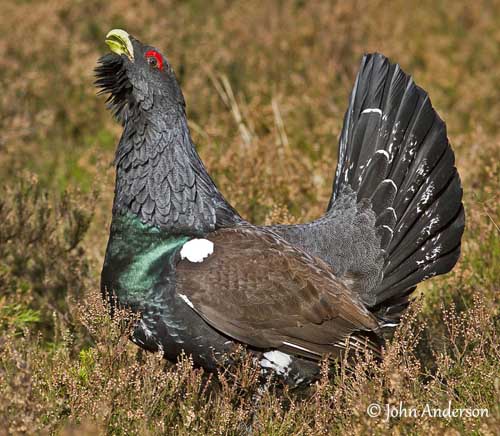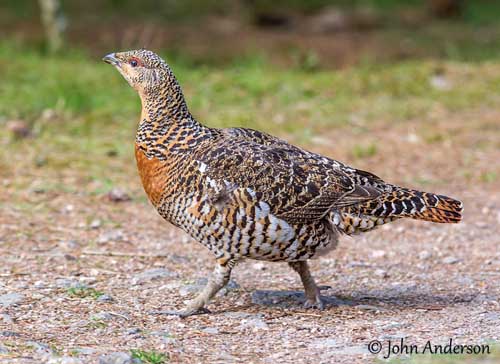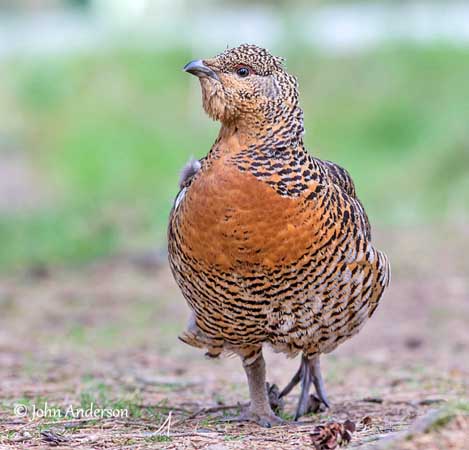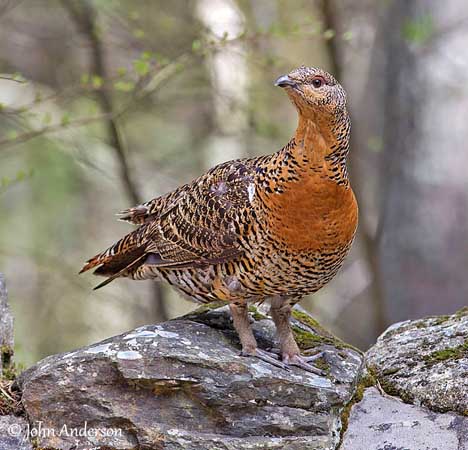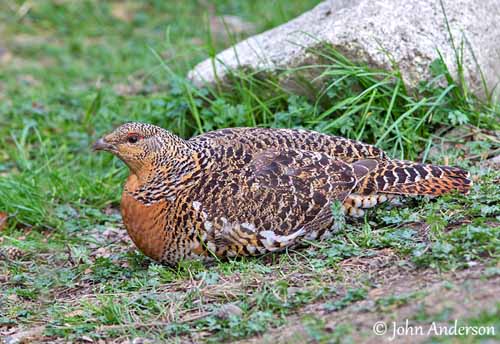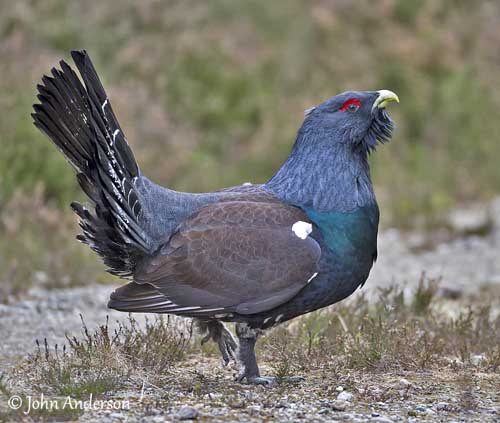
Fr: Grand tetras
All : Auerhuhn
Esp : Urogallo Común
Ital : Gallo cedrone
Nd: Auerhoen
Sd: Tjäder
Photographers:
John Anderson
John Anderson Photo Galleries
Text by Nicole Bouglouan
Sources:
HANDBOOK OF THE BIRDS OF THE WORLD Vol 3 by Josep del Hoyo-Andrew Elliott-Jordi Sargatal - Lynx Edicions - ISBN : 8487334202
THE HANDBOOK OF BIRD IDENTIFICATION FOR EUROPE AND THE WESTERN PALEARCTIC by Mark Beaman, Steve Madge - C.Helm - ISBN: 0713639601
THE COMPLETE BOOK OF BRITISH BIRDS – Written by “Royal Society for the Protection of Birds” experts - Préface de Magnus Magnusson - Michael Cady- Rob Hume Editors - ISBN: 0749509112
L’ENCYCLOPEDIE MONDIALE DES OISEAUX - Dr Christopher M. Perrins - BORDAS - ISBN: 2040185607
Hennache, A. & Ottaviani, M. (2005). Monographie des faisans, volume 1. Edition W.P.A. France, Clères, France. ISBN: 2-9512467-1-4
Hennache, A. & Ottaviani, M. (2006). Monographie des faisans, volume 2. Edition W.P.A. France, Clères, France.ISBN: 2-9512467-2-2
Les auteurs renoncent à leurs droits d'auteurs pour que la vente de cet ouvrage, publié par la World Pheasant Association, soit destinée à soutenir des projets de conservation.
BirdLife International (BirdLife International)
Wikipedia, the free encyclopaedia
Western Capercaillie
Tetrao urogallus
Galliforme Order – Tetraonidae Family
BIOMETRICS:
Lenght Male: 87 cm – F: 60 cm
Wingspan: 87-125 cm
Weight Male: 3900-4300 g (up to 6500 g) – F: 1700-2000 g
DESCRIPTION:
The Western Capercaillie is a large dark grouse of coniferous forests. This is the largest species of this family, closely associated to forest. Their mating displays are really spectacular.
The adult male has dark plumage, slate grey and narrowly vermiculated, mostly blackish on head and neck. Wings are dark brown with conspicuous white carpal patch.
Upper and undertail-coverts and underparts are dark grey to blackish, with variable amount of white, forming spots or streaks. Underwing-coverts are white. Breast is dark glossy blue/green. The tail is long and rounded with white-tipped feathers and shaft-streaks on rectrices, forming light whitish patches.
The strong bill is yellowish-white. The eyes are brown, with bright red comb above. Robust legs and feet are dark grey. Tarsi are feathered.

The first winter male is similar to adult but smaller. It has smaller and darker bill. In both sexes, tail feathers are narrower and the outer pair of primaries is reddish-brown.
The juvenile has pale fine streaks on mantle.
The chick is mostly reddish-brown overall, with greyish wings. The bill is pink with blackish upper mandible. The eyes are dark brown to black. It has the typical V-marking on the forehead.
There are twelve subspecies which differ in size and darkness of plumage.
VOICE: SOUNDS BY XENO-CANTO
The Western Capercaillie male can be very vocal during displays, producing series of knocking sounds, sometimes similar to sticks being taped together “plip-plip-plip-itit-t-t klop”, the last note recalls the sound of a cork popping from a bottle!
This series is followed by repeated harsh rasping wheezes. The male also produces loud guttural bubbling.
The female often utters several calls when watching for displaying males, with one similar to the “crow” of pheasants.
HABITAT:
The Western Capercaillie frequents forest and woodland, usually coniferous such as Pinus sylvestris, Picea, Abies and others, and mixed forest too. It is mostly found in wide areas of old, shady forest with damp soil and bogs, and dense undergrowth.
During winter, it can be seen in more open forest in the northern parts of the range, but during summer, it frequents dense forest with fruiting bushes where this species can breed and moult. In south of range, it is only found in mountain forest.
RANGE:
The Western Capercaillie is sedentary throughout its large range in N parts of Europe, W and C Asia and some patches in N Spain and C Europe. This species has been reintroduced in Scotland.
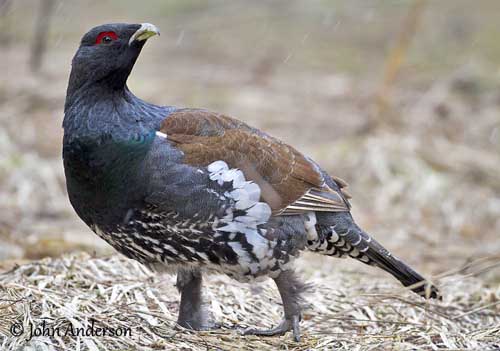
BEHAVIOUR:
The Western Capercaillie in winter feeds primarily on pine needles from several pines’ species. It feeds in trees at least for five months in North, but once the snow-cover disappeared, it comes to the ground.
But the diet is usually more varied in S of range, and includes holly leaves, birch buds in snowy weather, and also buds of fruit bushes and heaths of genus Erica.
During other periods and in summer, its diet includes needles, leaves, stems and berries of various plant species. Chicks feed on insects.
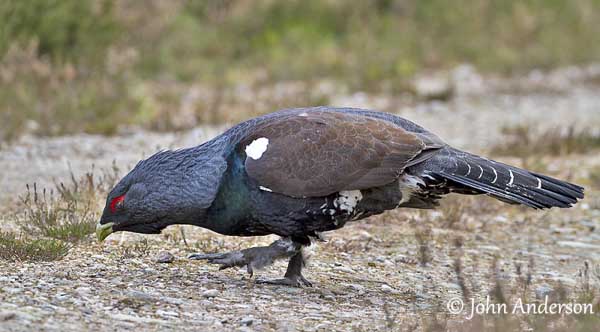
Usually, the Western Capercaillie calls from tree branch before to come down to the ground with a noisy flight. Then, the ground displays can start. A male may display alone or with other males, and mainly at dawn for safety.
During the ritual displays, the male cocks and fans widely its rounded tail. The wings are dropped in order to expose the white carpal patches. Such male challenges to rivals while uttering its peculiar “popping” song.
Females select males on visual factors such as beauty of plumage, song and vigour of displays, but also performances during confrontations.
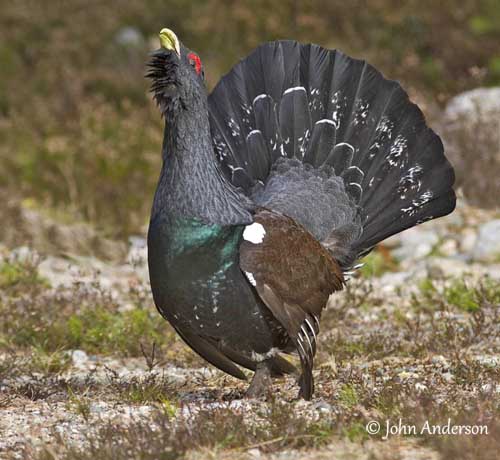
Males often fight in territorial defence, adopting ritual postures like during displays. They call and bow facing each other, pecking out at rival’s head but without true contact. However, disputes may turn into real fight with intensification of pecks and strong wing beats. Birds can be killed during such combats, or they die quickly due to injuries.
The Western Capercaillie is mainly sedentary in its range, only performing local movements in winter according to weather conditions and food resources.
FLIGHT:
The Western Capercaillie is mainly terrestrial but if flushed, it rises with noisy strong wingbeats. Then, its flight is silent. It is able to twist with agility between trees within dense forest. Wings are large and rounded and allow powerful wingbeats.
REPRODUCTION:
During the breeding season, the laying occurs between mid-April and mid-June.
The Western Capercaillie nests usually on the ground, often at base of tree in dense cover. But occasionally, it may use old abandoned nests placed some metres above the ground.
The nest on the ground is a shallow depression lined with grass, pine needles and twigs, sometimes feathers too. The female chooses the nest-site and performs alone all the nesting duties.
She lays 6-9 eggs and incubates during 26 days. Her cryptic plumage provides her good camouflage. Chicks are precocial but their mother keeps them warm regularly and at night during the first week. They are able to feed themselves on insects and they grow rapidly. They can fly at 2-3 weeks of age. They are sexually mature in first year, but males do not mate before three.
DIET:
The Western Capercaillie feeds on plant matter such as pine needles, leaves, stems, berries of various plants. Chicks feed on insects such as caterpillars of butterflies and pupae, ants, ground beetles… They feed mainly on the ground.
PROTECTION / THREATS / STATUS:
The Western Capercaillie appears to be decreasing, but populations are still fairly stable. However, excessive shooting, disturbance and pollution have led to serious declines in W Europe.
But currently, population size is extremely large and the species is not threatened.
